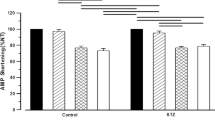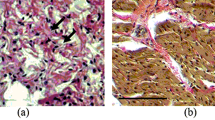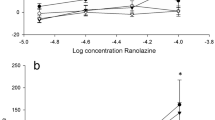Abstract
The action potential configuration of the left ventricular papillary muscle as well as the rosiglitazone-dependent changes in ventricular papillary muscle action potential amplitude were studied, and the duration was studied and compared in both healthy and diabetic rats. In this study, we used four groups: (1) nondiabetic control animals (C), (2) rosiglitazone-treated nondiabetic control animals (C+RSG), (3) diabetic animals (D), and (4) rosiglitazone-treated diabetic animals (D+RSG). Diabetes was induced by a single intravenous (i.v.) injection of streptozotocin (STZ). Conventional microelectrode techniques were applied to record action potentials after the establishment of diabetes (8 weeks after STZ treatment). Resting membrane potential (RMP) was decreased significantly in both RSG-treated C and D rats (from −70.2 ± 0.7 to −63.2 ± 0.7 and from −69.2 ± 0.4 to −61.2 ± 0.4). C+RSG and D+RSG groups showed increase in action potential amplitude compared with C and D groups (from 67.1 ± 0.8 to 68.2 ± 0.5 and from 67.1 ± 0.8 to 80.1 ± 0.8 and from 68.2 ± 0.5 to 79.3 ± 0.3) Depolarization time was significantly prolonged in diabetic rats (12.1 ± 0.4 to 27.5 ± 0.9). However, this prolongation in D+RSG group was significantly lower according to D group (from 27.5 ± 0.9 to 19.2 ± 0.7). There was no difference between C and C+RSG rats (12.1 ± 0.4 to 11.6 ± 0.2). Half repolarization time was also prolonged in diabetic rats (17.5 ± 0.6 to 59.9 ± 1.0). Moreover, D+RSG rats showed a slight and statistically insignificant difference according D rats (59.9 ± 1.0 to 55.9 ± 1.7). C+RSG rats showed a slight significant increase in half repolarization time compared with C group (17.5 ± 0.6 to 29.4 ± 0.7). Treatment of rats with RSG markedly decreased insulin resistance and also increased insulin sensitivity of the heart. Our data suggest that the beneficial effects of RSG treatment on the electrical activities of the diabetic rat papillary appear to be due to the diminished K+ currents, partially related to the decrease of hyperglycemia.









Similar content being viewed by others
References
Ahn HS, Kim SE, Jang HJ, Kim MJ, Rhie MJ, Yoon SE, Jo YH, Kim MS, Sung KW, Kim SY, Hahn SJ (2007) Open channel block of Kv1.3 by rosiglitazone and troglitazone: Kv1.3 as the pharmacological target for rosiglitazone Naunyn-Schmiedeberg’s Arch Pharmacol 374:305–309
Aomine M, Nobe S, Arita M (1990) Increased susceptibility to hypoxia of prolonged action potential duration in ventricular papillary muscles from diabetic rats. Diabetes 39 1485–1489
Apkon M, Nerbonne JM (1991) Characterization of two distinct depolarization activated K+ currents in adult rat ventricular myocytes. J Gen Physiol 97:973–1011
Bonnevie-Nielsen, MW, Lernmark A (1981) A major loss in islet mass and B-cell function precedes hyperglycemia in mice given multiple low doses of streptozotocin. Diabetes 30:424–429
Choi JS, Hahn SJ, Rhie DJ, Yoon SH, Jo YH, Kim MS (1999) Mechanism of fluoxetine block of cloned voltage-activated potassium channel Kv1.3. J Pharmacol Exp Ther 291:1–6
Eto K, Ohya Y, Nakamura Y, Abe I, Fujishima M (2001) Comparative actions of insulin sensitizers on ion channels in vascular smooth muscle. Eur J Pharmacol 423:1–7
Fang Zy, Prins Jb, Marwick Th (2004) Diabetic cardiomyopathy: evidence, mechanisms, and therapeutic implications. Endocr Rev 25:543–567
Fein FS, Kornstein IB, Strobeck JE, Capasso JM, Sonnenblick EH (1980) Altered myocardial mechanics in diabetic rats. Circ Res 47:922–933
Fein FS, Aronson RS, Nordin C, Miller-Green B, Sonnenblick EH (1983) Altered myocardial response to ouabain in diabetic rats: Mechanics and electrophysiology. J Mol Cell Cardiol 15:769–784
Gargiulo P, Jacobellis G, Vaccari V, Andreani D (1998) Diabetic cardiomyopathy: Pathophysiological and clinical aspects. Diabetes Nutr Metab 11:336–346
Horackova M, Murphy MG (1988) Effects of chronic diabetes mellitus on the electrical and contractile activities, 45Ca2+transport, fatty acids profiles and ultrastructure of isolated ventricular myocytes. Pflugers Arch 411:564–572
Jarret Rj (1989) Cardiovascular disease and hypertension in diabetes mellitus. Diabet Metab Rev 5:547–558
Knock GA, Mishra SK, Aaronson PI (1999) Differential effects of insulin-sensitizers troglitazone and rosiglitazone on ion currents in rat vascular myocytes. Eur J Pharmacol 368:103–109
Kotchen TA, Yang HY, Reddy S, Hoffman RG (1996) Effect of pioglitazone on vascular reactivity in vivo and in vitro. Am J Physiol 270:R660–R666
Lagadic-Gossmann D, Buckler KJ, Prigent KL, Feuvray, D (1996) Altered Ca2+handling in ventricular myocytes isolated from diabetic rats. Am J Physiol 270:H1529–H1537
Lehmann JM, Moore LB, Smith-Oliver TA, Wilkison WO, Willson TM, Kliewer SA (1995) An antidiabetic thiazolidinedione is a high affinity ligand for peroxisome proliferator-activated receptor gamma (PPAR gamma). J Biol Chem 270:12953–12956
Maghoub MA, Abd-Elfattah AS (1998) Diabetes mellitus and cardiac function. Mol Cell Biochem 180:59–64
Magyar J, Rusznak Z, Szentesi P, Szucs G, Kovacs LJ (1992) Action potentials and potassium currents in rat ventricular muscle during experimental diabetes. J Mol Cell Cardiol 24(8):841–853
Magyar J, Cseresnyes Z, Rusznak Z, Sipos I, Szucs G, Kovacs L (1995) Effects of insulin on potassium currents of rat ventricular myocytes in streptozotocin diabetes. Gen Physiol Biophys 14(3):191–201
Mitchell MR, Powell T, Terrar DA, Twist VW (1984) The effects of ryanodin, EGTA and low-sodium on action potentials in rat and guinea-pig ventricular myocytes: evidence for two inward currents during the plateau. Br J Pharmacol 81:543–550
Nobe S, Aomine M, Arita M, Ito S, Takaki R (1990) Chronic diabetes mellitus prolongs action potential duration of rat ventricular muscles: circumstantial evidence for impaired Ca2+channel. Cardiovasc Res 24:381–389
Ramesh B, Pugalendi KV (2007) Influence of umbelliferone on membrane-bound ATPases in streptozotocin-induced diabetic rats. Pharmacol Rep 59(3):339–348
Saltiel AR, Olefsky JM (1996) Thiazolidinediones in the treatment of insulin resistance and type II diabetes. Diabetes 45:1661–1669
Shimoni Y, Ewart HS, Severson D (1999) Insulin stimulation of rat ventricular K+ currents depends on the integrity of the cytoskeleton. J Physiol 514(Pt 3):735–745
Shimoni Y, Firek L, Severson D, Giles W (1994) Short-term diabetes alters K+ currents in rat ventricular myocytes. Circ Res 74:620–628
Shimoni Y, Severson D, Giles W (1995) Thyroid status and diabetes modulate regional differences in potassium currents in rat ventricle. J Physiol 488(3):673–688
Song J, Walsh MF, Igwe R, Ram JL, Barazi M, Dominguez LJ, Sowers JR (1997) Troglitazone reduces contraction by inhibition of vascular smooth muscle smooth muscle cell Ca2q currents and not endothelial nitric oxide production. Diabetes 46:659–664
Unlugenc H, Emre M, Demir C, Guler T, Kavak S, Isik G (2007) Remifentanil-induced mechanical responses and membrane potential changes in human umbilical arteries. Acta Anaesthesiol Scand 51(2):244–251
Valenzuela C, Delpon E, Franqueza L, Gay P, Perez O, Tamargo J, Snyders DJ (1996) Class III antiarrhythmic effects of zatebradine. Time-, state-, use-, and voltage-dependent block of hKv1.5 channels. Circulation 94:562–570
Wagstaff AJ, Goa KL (2002) Rosiglitazone: a review of its use in the management of type 2 diabetes mellitus. Drugs 62:1805–1837
Zhang F, Sowers JR, Ram JL, Standley PR, Peuler JD (1994) Effects of pioglitazone in calcium channels in vascular smooth muscle. Hypertension 24:170–175
Acknowledgements
This work was supported by the Çukurova University Research Projects Department (No. TF2006D3). We thank Prof. Dr. Mustafa Şan, Prof. Dr. İsmail Meral, and Assist. Prof Dr. Abdi Bozkurt.
Author information
Authors and Affiliations
Corresponding author
Rights and permissions
About this article
Cite this article
Kavak, S., Emre, M., Tetıker, T. et al. Effects of rosiglitazone on altered electrical left ventricular papillary muscle activities of diabetic rat. Naunyn-Schmied Arch Pharmacol 376, 415–421 (2008). https://doi.org/10.1007/s00210-007-0234-y
Received:
Accepted:
Published:
Issue Date:
DOI: https://doi.org/10.1007/s00210-007-0234-y




